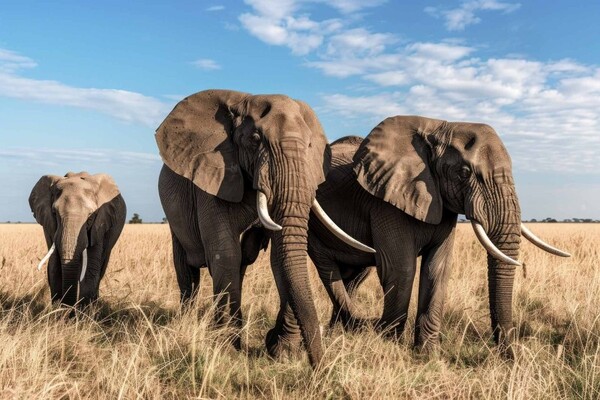Elephants, the largest land animals on Earth, are renowned for their intelligence, strong social bonds, and impressive size. Their sheer bulk makes them formidable creatures in the animal kingdom. However, while adult Elephants-Are-Endangered.html">elephants have very few natural predators, certain animals may pose a threat, particularly to younger or weaker members of the herd. In this article, we will delve into the animals that hunt Elephants-Are-Endangered.html">elephants, the circumstances under which these predatory relationships occur, and the broader implications for elephant populations and ecosystems.

Lions are perhaps the most famous predators that occasionally hunt elephants. Typically, adult lions do not target full-grown elephants due to their size and strength. However, they may attempt to hunt young elephants or calves, especially if they are isolated from their mothers or the herd. Lion prides may work together to tackle an elephant calf, leveraging their teamwork to increase their chances of a successful hunt. Such events are rare and often occur in times of food scarcity, demonstrating the desperate measures predators may resort to.
Crocodiles can pose a threat to elephants, particularly near water sources where elephants come to drink. Young elephants or calves are most at risk, as they may not be as vigilant as adults. Although crocodile attacks on elephants are uncommon, there have been documented instances where crocodiles ambushed juvenile elephants near rivers or lakes. These predatory attacks highlight the dangers that lurk in seemingly safe environments.
Hyenas, while not typically hunters of large prey like elephants, can be opportunistic scavengers. If a young or sick elephant falls behind its herd or becomes injured, hyenas may take advantage of the situation. They are more likely to feed on the carcass of an elephant that has died from other causes rather than actively hunting one. Their presence often indicates the health of the ecosystem and the potential vulnerabilities of elephant populations.
While the primary predators of elephants are lions and crocodiles, other carnivores like leopards and wild dogs may occasionally threaten young or weak individuals, especially if food is scarce. However, these incidents are much less common compared to lion attacks.
Despite having few natural predators, elephants face significant threats from human activities. The primary dangers include:
One of the most critical threats to elephant populations is poaching for ivory. Elephants are hunted for their tusks, which are highly valued on the black market. This illegal trade has led to devastating declines in elephant numbers, especially in Africa.
Human encroachment into natural habitats has drastically reduced the space available for elephants. Deforestation, agricultural expansion, and urban development fragment their habitats, isolating herds and making them more vulnerable to predators. Habitat loss also limits their access to food and water, stressing populations.
As human populations grow, encounters between humans and elephants are becoming more frequent. Elephants may raid crops or enter villages in search of food, leading to conflicts that can result in harm to both elephants and humans. In some cases, this conflict leads to retaliation against elephants, further decreasing their numbers.
Elephants play a crucial role in maintaining the health of their ecosystems. As large herbivores, they help control vegetation growth, which promotes biodiversity. Their feeding habits can create clearings that allow other species to thrive, and their dung provides nutrients for plants and helps disperse seeds.
By preserving elephant populations, we support the overall health of ecosystems, which benefits countless other species and contributes to environmental stability.
Given the threats facing elephants, various conservation efforts are underway to protect them. These initiatives include:
Anti-Poaching Measures: Increased patrols and monitoring in elephant habitats help combat poaching. Wildlife protection organizations work tirelessly to reduce illegal hunting.
Habitat Protection: Establishing wildlife reserves and protected areas ensures that elephants have safe spaces to roam and access resources.
Community Engagement: Educating local communities about the importance of elephants and providing alternative livelihoods can reduce human-elephant conflict. When people understand the ecological benefits of elephants, they may be more inclined to protect them.
Legislation: Strengthening laws against poaching and the ivory trade is crucial for the long-term survival of elephants.
In conclusion, while adult elephants face few natural predators, young or weakened individuals may be hunted by lions, crocodiles, and occasionally hyenas. However, the most significant threats to elephant populations arise from human activities, including poaching, habitat loss, and human-elephant conflict.
Understanding these dynamics is essential for effective conservation efforts aimed at protecting these magnificent creatures. By supporting initiatives that safeguard elephant populations and their habitats, we can help maintain the balance of nature and preserve the legacy of elephants for future generations. The survival of these incredible animals not only enriches biodiversity but also enhances the ecosystems they inhabit, making them vital to the health of our planet.
Elephants, the majestic giants of the animal kingdom, are not just iconic for their size but also for their vital role in maintaining ecological balance. Unfortunately, these magnificent creatures face severe threats from poaching, habitat loss, and human-wildlife conflict. In this article, we will explore the importance of saving elephants, the challenges they face, and the global efforts being made to protect both elephants and their habitats.
In many cultures, elephants symbolize wisdom, strength, and family. They are featured in art, folklore, and religious practices, reflecting the deep connection humans have with these animals. Preserving elephants means preserving cultural heritage for many communities around the world.
One of the most significant threats to elephants is poaching for their tusks. Illegal ivory trade has led to a dramatic decline in elephant populations, especially in Africa. Criminal organizations often engage in brutal practices to obtain ivory, leading to not only the loss of elephants but also devastating impacts on local communities.
With habitat loss, elephants often come into contact with human settlements. This can lead to conflicts, as elephants may raid crops or destroy property in search of food. These interactions can result in harm to both elephants and humans, often leading to retaliatory killings of elephants.

Numerous organizations are dedicated to the protection of elephants and their habitats. These groups work on the ground to combat poaching, conduct research, and promote sustainable land use. Notable organizations include:
The World Wildlife Fund (WWF): Engages in advocacy, education, and direct conservation efforts.
Elephant Family: Focuses on protecting elephants in Asia and their habitats through various initiatives.
Save the Elephants: Conducts research and conservation projects aimed at understanding and protecting elephant populations.
Engaging local communities is essential for successful conservation. Many initiatives focus on educating people about the importance of elephants and providing alternative livelihoods. By involving communities in conservation efforts, there is a greater chance of reducing human-wildlife conflict and promoting coexistence.
Stronger laws and international agreements are crucial for protecting elephants. Initiatives like the Convention on International Trade in Endangered Species (CITES) regulate ivory trade and help protect endangered species. Governments are encouraged to enforce these laws and increase penalties for poaching and trafficking.
Restoring degraded habitats is vital for the survival of elephants. Conservation projects often involve reforestation, creating wildlife corridors, and protecting critical areas from development. These efforts ensure that elephants have the space they need to thrive.
Every individual can play a part in saving elephants and their habitats. Here are some ways you can contribute:
Support Conservation Organizations: Donate to or volunteer with organizations working to protect elephants.
Raise Awareness: Share information about elephant conservation on social media or within your community.
Make Sustainable Choices: Choose products that do not contribute to habitat destruction or wildlife trafficking.
Advocate for Stronger Laws: Support legislation that protects wildlife and their habitats.
Saving elephants and their habitats is a global responsibility that requires concerted efforts from individuals, communities, and nations. By understanding the challenges elephants face and supporting conservation initiatives, we can help ensure a future where these magnificent creatures continue to roam the Earth. Together, we can protect not only elephants but also the rich biodiversity of the ecosystems they inhabit, creating a healthier planet for all living beings.

Elephants are often celebrated for their intelligence, social structure, and gentle nature. However, they can also pose significant dangers to humans, especially in areas where their habitats overlap with human populations. In this article, we will explore the behaviors of elephants that can lead to dangerous encounters, examine statistics on human injuries and fatalities caused by elephants, and discuss the importance of understanding these interactions for better coexistence.
Elephants are large, powerful animals that can exhibit aggressive behaviors when they feel threatened or provoked. Some common triggers for such behavior include:
Protecting Their Young: Mother elephants are fiercely protective of their calves. If they perceive a threat, they may charge at humans or other animals to defend their young.
Territorial Defense: Elephants are known to have home ranges and may become aggressive when humans encroach on their territory, especially if they feel cornered.
Stress and Disturbance: Factors such as habitat loss, poaching, and human encroachment can lead to increased stress in elephants, causing them to act unpredictably.
Charging: When elephants feel threatened, they may charge at perceived threats. This can happen if humans inadvertently get too close or if an elephant feels startled.
Crop Raiding: In agricultural areas, elephants may invade farms for food. This can lead to confrontations with farmers, sometimes resulting in injury or death.
Road Accidents: As elephants cross roads, they can cause accidents, especially at night when visibility is low. Collisions with vehicles can result in serious injuries or fatalities for both humans and elephants.
While exact statistics can vary by region and year, here are some insights into human-elephant conflicts:
According to various studies, it is estimated that approximately 100 to 500 people are killed by elephants each year in countries where elephants and humans coexist, particularly in Africa and parts of Asia.
In addition to fatalities, thousands of people are injured annually due to elephant encounters. These injuries can range from minor to severe, often resulting from charging incidents or conflicts during crop raiding.
The risk of encountering dangerous elephant behavior is heightened in areas where human populations are expanding into traditional elephant habitats. As forests are cleared for agriculture and urban development, elephants are forced into closer proximity to humans.
Awareness: Educating local communities about elephant behavior and the risks associated with living near elephants is crucial. Awareness can help people recognize warning signs and avoid dangerous encounters.
Training: Providing training to farmers and communities on how to manage elephant interactions can reduce the likelihood of conflicts. For instance, using non-lethal deterrents can help keep elephants away from crops.
Crop Protection: Implementing protective measures, such as building barriers around farms, can reduce crop raiding. Additionally, using methods like noise-makers or lights can deter elephants from entering agricultural areas.
Wildlife Corridors: Establishing wildlife corridors can help elephants move safely between habitats without encountering human settlements. This reduces the chance of conflicts while allowing elephants to access food and water.
Community Engagement: Involving local communities in conservation efforts can foster a sense of ownership and responsibility. Communities that benefit from elephant conservation are more likely to protect both elephants and their habitats.
Stronger Laws: Governments can implement stronger regulations to protect both elephants and human populations. Laws that promote sustainable land use and prevent poaching can help create safer environments.
Conflict Resolution Programs: Establishing programs that compensate farmers for losses due to elephant damage can help alleviate tensions and promote coexistence.
While elephants can pose dangers to humans, understanding their behaviors and the context of these interactions is key to fostering coexistence. With annual fatalities ranging from 100 to 500 people in conflict areas, it is essential to prioritize education, community engagement, and effective mitigation strategies. By taking proactive measures to reduce conflicts, we can create safer environments for both humans and elephants, ensuring that these magnificent creatures continue to thrive in the wild while minimizing risks to human life. Together, we can work towards a harmonious relationship between humans and elephants, celebrating their importance in our ecosystems.
animal tags: elephant
We created this article in conjunction with AI technology, then made sure it was fact-checked and edited by a Animals Top editor.